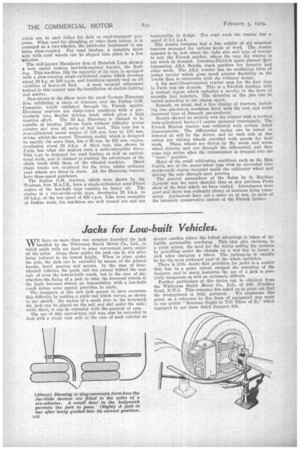Jacks for Low-built Vehicles.
Page 30

If you've noticed an error in this article please click here to report it so we can fix it.
WTE have on more than one occasion described the jack V V handled by the Whiteman Smith Motor Co., Ltd., in which guide rails are fixed to some convenient parts under all the axles. Along these guides the jack can be slid after being reduced to its lowest height. When in place under the axle, the jack can be extended by means of the jointed handle, bevel gearing and screws. In the case of fourwheeled vehicles, the guide rail can extend behind the rear axle of even the lowest-built coach, but in the case of six. wheelers the fixing of a jack to raise the foremost wheels of the bogie becomes almost an impossibility with a low-built coach unless some special provision be made.
The designers of this new jack appear to have overcome " this difficulty by making a guide rail which curves, as shown in our sketch. By means of a small door in the bodywork the jack can be placed on the rail and slid under the axle ; while there, it can be extended with the greatest of ease. The use of this curved-type rail may also be extended to deal with a single rear axle in the case of such vehicles as sleeper coaches where the fullest advantage is taken of the legally permissible overhang. This idea also obviates, to a great extent, the need for the driver soiling his uniform by grovelling under the chassis an a wet day to locate a jack when changing a wheel. The jacking-up is usually by far the most awkward part of the whole operation.
There is little doubt that provision for jacks is a matter that has to a great extent escaped the attention of the designer, and in many instances the use of a jack is positively dangerous as well as extremely difficult.
Further particulars of this device can be obtained from the Whiteman Smith Motor Co., Ltd., of 100, Finchley Road, N.W.3. This company has asked us to point out that the arrangement is fully patented. We emphasize this point, as a reference to this form of equipment was made in our article "Someone Ought to Tell Them of It," which appeared in our issue dated January 8th.


































